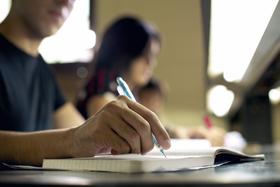Interlake High School is a public secondary school in Bellevue, Washington, one of the four traditional high schools in the Bellevue School District. Its mascot is a Saint Bernard named Bernie, and the school's sports teams are known as the "Saints."
Serving 1,604 students in grades 9-12, Interlake Senior High School ranks in the top 5% of all schools in Washington for overall test scores (math proficiency is top 10%, and reading proficiency is top 10%).
The percentage of students achieving proficiency in math is 74% (which is higher than the Washington state average of 41%). The percentage of students achieving proficiency in reading/language arts is 89% (which is higher than the Washington state average of 53%).
The student-teacher ratio of 20:1 is higher than the Washington state level of 16:1.
Minority enrollment is 78% of the student body (majority Asian), which is higher than the Washington state average of 52% (majority Hispanic and Asian).
Quick Facts (2025-26)
- Grades: 9-12
- Enrollment: 1,604 students
- Student-Teacher Ratio: 20:1
- Minority Enrollment: 78%
- Graduation Rate: 91% (Top 30% in WA)
- Overall Testing Rank: Top 5%
- Math Proficiency: 74% (Top 10%)
- Reading Proficiency: 89% (Top 5%)
- Science Proficiency: 86% (Top 5%)
- Source: National Center for Education Statistics (NCES), WA Dept. of Education
Top Rankings
Interlake Senior High School ranks among the top 20% of public schools in Washington for:
Category
Attribute
Overall Rank
Math Proficiency
Reading/Language Arts Proficiency
Science Proficiency
School Overview
Interlake Senior High School's student population of 1,604 students has declined by 7% over five school years.
The teacher population of 82 teachers has declined by 11% over five school years.
Grades Offered
Grades 9-12
(No virtual instruction)
(No virtual instruction)
Total Students
1,604 students
Gender %
Total Classroom Teachers
82 teachers
Year Founded
1967
Colors
White, Navy Blue, Columbia blue
School Calendar
School Rankings
Interlake Senior High School ranks within the top 5% of all 2,088 schools in Washington (based off of combined math and reading proficiency testing data).
The diversity score of Interlake Senior High School is 0.69, which is equal to the diversity score at state average of 0.69. The school's diversity has stayed relatively flat over five school years.
Overall Testing Rank
#56 out of 2088 schools
(Top 5%)
(Top 5%)
Math Test Scores (% Proficient)
74%
41%
Reading/Language Arts Test Scores (% Proficient)
89%
53%
Science Test Scores (% Proficient)
86%
49%
Student-Teacher Ratio
20:1
16:1
American Indian
n/a
1%
Asian
48%
9%
Hispanic
18%
26%
Black
4%
5%
White
22%
48%
Hawaiian
1%
2%
Two or more races
7%
9%
All Ethnic Groups
Graduation Rate
91%
84%
Eligible for Free Lunch
27%
49%
Eligible for Reduced Lunch
7%
8%
School Statewide Testing
School District Name
Source: National Center for Education Statistics (NCES), WA Dept. of Education
School Notes
- School Mascot: St. Bernard
Profile last updated: 02/09/2025
Frequently Asked Questions
What is Interlake Senior High School's ranking?
Interlake Senior High School is ranked #56 out of 2,088 schools, which ranks it among the top 5% of public schools in Washington.
What schools are Interlake Senior High School often compared to?
Interlake Senior High Schoolis often viewed alongside schools like Newport Senior High School by visitors of our site.
What percent of students have achieved state testing proficiency in math and reading?
74% of students have achieved math proficiency (compared to the 41% WA state average), while 89% of students have achieved reading proficiency (compared to the 53% WA state average).
What is the graduation rate of Interlake Senior High School?
The graduation rate of Interlake Senior High School is 91%, which is higher than the Washington state average of 84%.
How many students attend Interlake Senior High School?
1,604 students attend Interlake Senior High School.
What is the racial composition of the student body?
48% of Interlake Senior High School students are Asian, 22% of students are White, 18% of students are Hispanic, 7% of students are Two or more races, 4% of students are Black, and 1% of students are Hawaiian.
What is the student-teacher ratio of Interlake Senior High School?
Interlake Senior High School has a student ration of 20:1, which is higher than the Washington state average of 16:1.
What grades does Interlake Senior High School offer ?
Interlake Senior High School offers enrollment in grades 9-12 (No virtual instruction).
What school district is Interlake Senior High School part of?
Interlake Senior High School is part of Bellevue School District.
In what neighborhood is Interlake Senior High School located?
Interlake Senior High School is located in the Northeast Bellevue neighborhood of Bellevue, WA. There are 3 other public schools located in Northeast Bellevue.
School Reviews
Review Interlake Senior High School. Reviews should be a few sentences in length. Please include any comments on:
- Quality of academic programs, teachers, and facilities
- Availability of music, art, sports and other extracurricular activities
Recent Articles

School Vouchers: Updated Pros and Cons (2025 Review)
Comprehensive 2025 analysis of school vouchers, weighing benefits and challenges for families, funding, outcomes, and policy directions.

Benefits and Drawbacks of Homework in 2025
Explore updated 2025 insights on homework鈥檚 benefits, drawbacks, mental health impact, best practices, and policy trends in U.S. public schools.

Charter Schools vs Public Schools 2025: Key Differences & Trends
Explore updated 2025 insights comparing charter schools vs public schools, enrollment, academic outcomes, funding, and real-world examples for families and educators.





